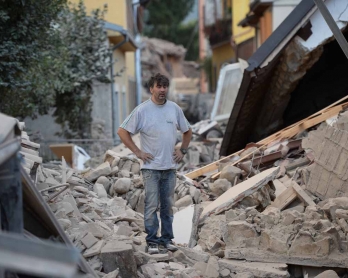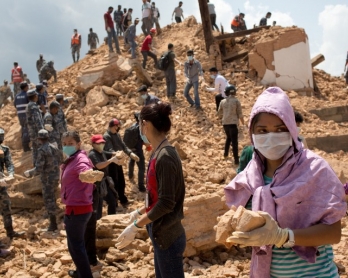When the earth trembles and deja-vu strikes
Rome -- My phone buzzes: "Earthquake 5.3 magnitude hits central Italy", the flash says.
I don't feel the quake as I navigate Roman potholes in our old banger, but anxiety grips me anyway, thoughts fighting each other for space.
It's 10:26am. Where did it hit? If it struck Abruzzo again, in the same area as the quakes last year, that could be a blessing in disguise as many of the houses have been evacuated. Roofs may have fallen in, walls may have collapsed, but we know many homeowners are now living in emergency accommodation on the coast, well clear of the danger. But what if it's a different fault-line…
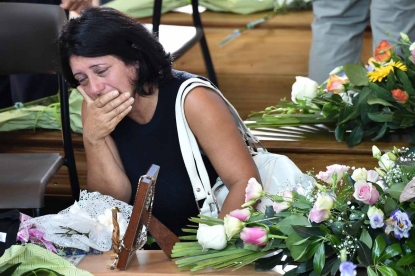 A woman mourns next to a coffin of an earthquake victim in August, 2016.
(AFP / Alberto Pizzoli)
A woman mourns next to a coffin of an earthquake victim in August, 2016.
(AFP / Alberto Pizzoli)Memories of covering the deadly night-time August quake return: watching in silence as a digger turned up comic books and clothes from the rubble of one house and finally unearthed a mattress and a teenage girl's body. Failing to find the words to comfort the woman whose sister was still trapped, likely dead.
Second flash: it is Abruzzo, but the epicentre is a different town. I rush home to pack a few things. In August survivors camped in blossoming gardens or green fields up in one of the most beautiful mountainous areas in Italy. I remember the smell, the hot sun, the sweaty journalists, the bodies alive and dead.
This time the area would be buried under record levels of snow and ice.
 (AFP / Filippo Monteforte)
(AFP / Filippo Monteforte)What to pack? Tights to go under trousers, walking boots, vests, hat, gloves, and always, always on occasions like this, lots of clean underwear as you don't know how long you'll be gone. And an umbrella to keep the camera dry.
I head to meet AFPTV colleague Giovanni Grezzi at the car hire office. Does the four-wheeler we are renting include snow chains? Yes? Good (No it didn't, we discover later). We swing by to pick up photographer Andreas Solaro and we're off.
We listen in silence to the radio on the way: three more quakes, each measuring over 5 on the Richter scale. The epicentre is a town called Montereale, it's snowing and there is a police roadblock as parts of the route are still snowed under. We fear we'll be turned back (we begin debating how much of the equipment we could carry on our backs through the snow up a mountain). We make it through the roadblock.
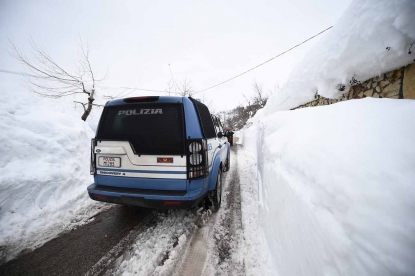 (AFP / Filippo Monteforte)
(AFP / Filippo Monteforte)We spot a group of cows on the outskirts of the town standing in deep snow and stop to film them. The silence is thick, our only company a blind old sheep dog. Then the farmer arrives and we do our first interview. Part way through the ground shakes beneath us -- another quake, small but angry. It is the first one I've felt since the news broke this morning and it is like suddenly meeting an old acquaintance, admittedly one you hate and fear. Along with the surge of adrenaline comes the sense of deja vu and it oddly bolsters me.
It doesn't stop there. This is an area we grew to know well last year but while the landscape is familiar, it's also utterly alien. The streets of the town that haven't been cleared are covered in such deep snow it comes halfway up the front doors. People describe the moment the first quake hit. The words are the same; abject terror, the ground shaking as if it would never stop, but now the enemies are the cold, the ice, the darkness.
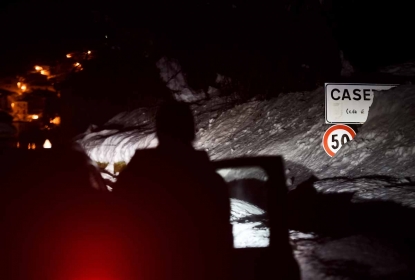 (AFP / Filippo Monteforte)
(AFP / Filippo Monteforte)At supper in our hotel that night (a familiar a moment of guilt, as we think of those trapped with nothing), a fresh alert lights up my phone: "Avalanche hits hotel, at least 20 people inside". I'm in denial. A large hotel could probably shrug it off, perhaps there are no victims, I say. There is no point setting off now in the dark anyway as the roads are too dangerous, so we agree to wait until morning, but sleep uneasily.
We wish we'd thought to bring sunglasses for the glare off the snow the next day. Most of the motorway exits in the area are closed, so we're forced to come off at the only open one and try and go round another way. There's no mobile phone reception (a journalist's nightmare), and we begin to worry about fuel.
Rest-stops we come across are closed after a blackout and our GPS is down too. We finally find an open petrol station and fill up not just on fuel but crisps and water too (the only provisions they have left). We joke that we should have brought skis with us, but I'm on edge and secretly wishing I had the sort of waterproof trousers and snow boots the others have brought. Locals give us directions the way only Italians know how: determined to help, each asking a friend or passerby, lots of tutting and shaking of heads and saying the roads are closed and "well, good luck then" as we set off.
The hotel is near the picturesque mountainside town of Farindola, but as we approach the turning it's clear we're not going to make it up -- the snow is over two metres deep here and emergency services are trying to clear it for rescuers.
Journalists are a nuisance and we're told to head to nearby Penne (no connection with the pasta) where a coordination centre has been set up in a sports hall. It's already dark by this point and with fears another avalanche could hit the area soon, I'm not keen to make the headlines next morning: "Rescuers trying to save hotel guests have to waste time digging out stupid journalists too".
The centre becomes our home for the next three days: there's always a sense of camaraderie on these occasions, as journalists who have covered all sorts of disasters and breaking news stories across the country come together again. We besiege Luca Cari, national firefighters spokesman, whom we got to know well during the coverage of the Concordia cruise ship disaster in 2012, and who already looks exhausted and underwhelmed to see us. A poor spokesman for the Alpine rescue service becomes the most-wanted man on site, as he is not only good on details of the rescue op, but also looks good on camera.
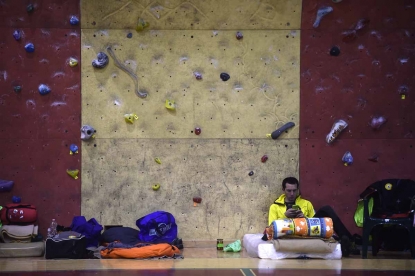 The rescue operations center in Penne.
(AFP / Filippo Monteforte)
The rescue operations center in Penne.
(AFP / Filippo Monteforte)A separate AFP team attempts to get up to the Rigopiano hotel, which we learn was hit by an avalanche with the force of 4,000 trucks driving full speed. The number of missing is set at over 30, though it's unclear how many people were inside.
But "it's a no go. The snow's over four metres deep and there's a police block you can't get around", they say.
Shivering despite our winter gear, we gaze up through flurries of snow at the hostile mountain and speak to rescue teams as they study maps of the terrain and the layout of the hotel before heading up to dig with shovels and bare hands. One of them stops to show me their gear and I think how young they are and how brave -- and at the same time plot how to persuade them to give us a lift up to the site without authorisation (no luck).
We are lying in wait the next morning as they return. We swoop on the slowest one, catching him off his guard, and before he knows it, he has some 20 journalists with television cameras in his face, pressing him up against a car and demanding an update. He speaks falteringly at first, describing how they had been alerted to air pockets under the rubble by small fires that had broken out inside the collapsed structure.

Then the words begin to tumble out of him: the smell of burning, the dig down to find the roof, the depths other rooms may be at, the sniffer dogs rendered useless by the chlorine from the hotel's swimming pool (mental note: interview dog handlers?)
Then word spreads of a group of people found alive, and so begins a day of confusion: how many people? Together or in separate areas? Were the four missing children among them? The family of the man who sounded the alarm? The young couple whose photograph had gone viral on social networks?
Officials are unwilling to tell us anything: rescuers are using video scopes to try and see those trapped, but access is difficult and they are largely relying on vocal contact. How many individual voices they are hearing cannot be confirmed, nor will they number survivors who might die of injuries.
"They've found a little girl alive!" screams a large Italian female on-camera reporter hysterically. "I've got an exclusive!"
"Can we match?" asks the bureau in Rome. No we can't -- and good thing, as the news turns out to be bogus.
The media circus is penned into a section of the sports hall stands and we have to resort to calling press officers just metres away on their mobile phones. The attempt to get up the mountain continues, each media giving it a go, and we wouldn't put it past some of our colleagues to try and do a "live" broadcast from inside one of the narrow holes the fire brigade is digging through the rubble.
We are told a group of six people has been found in the hotel's kitchen. Then it becomes an attic space, or may be the lobby. We fret over where. While perhaps a small detail in terms of news reporting, it makes it clear the rescuers are having difficulties identifying which parts of the wreckage to search.
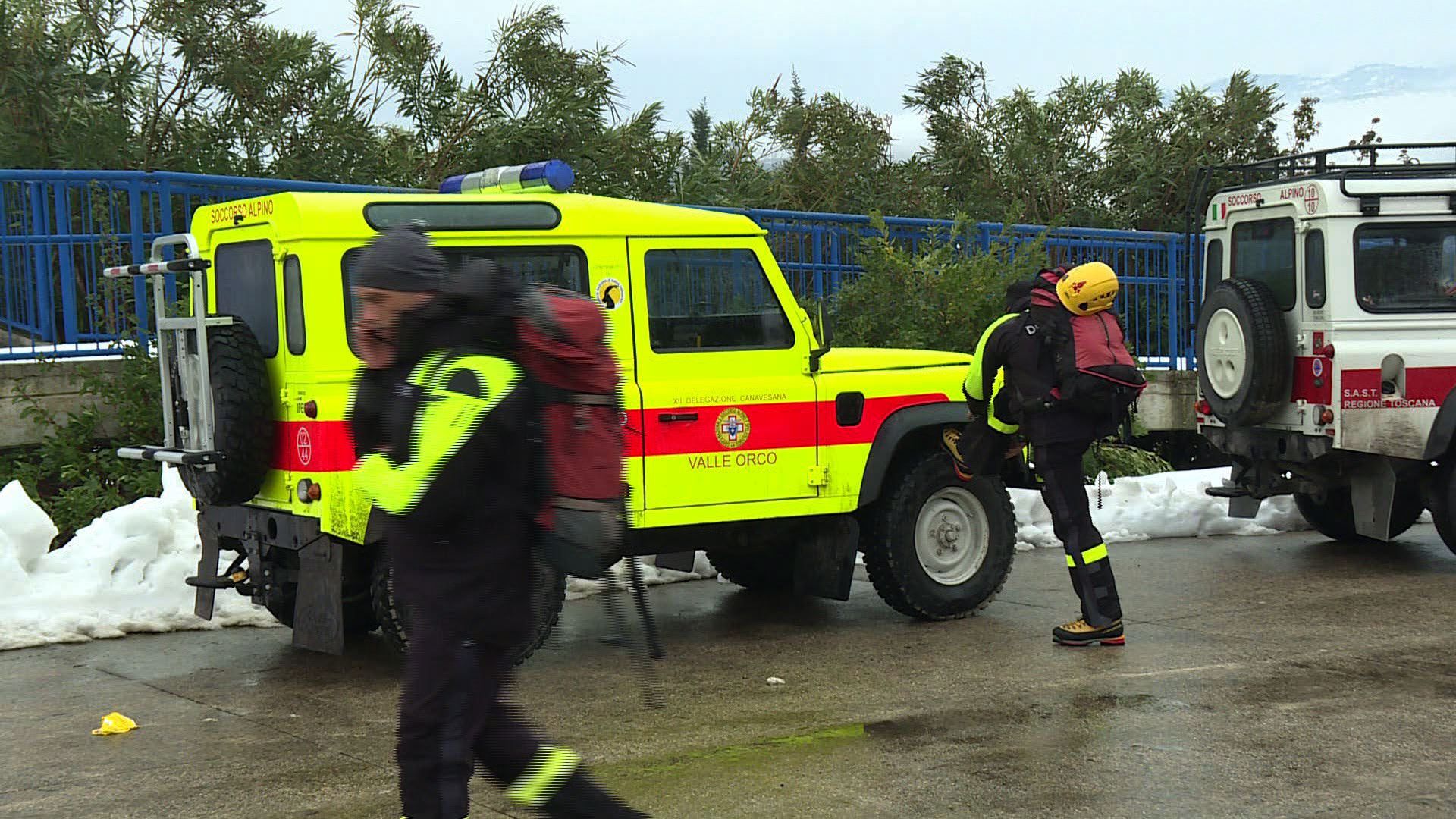
The discovery of all of the children spurs rescuers on and boosts morale but we find it increasingly frustrating having to rely on video and photo handouts from the emergency services. How can we verify what's really going on at the site?
Rome tries to organise a helicopter to take someone up but it's called off as the weather worsens.
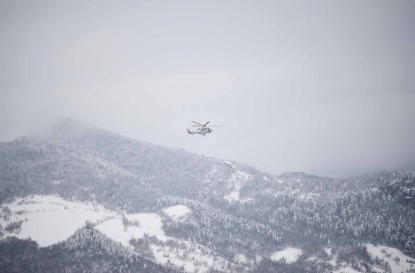 (AFP / Filippo Monteforte)
(AFP / Filippo Monteforte)Officials refuse to take us in one of vehicles shuttling rescuers back and forth, insisting the site is too dangerous. Patience wears thin, rescuers and press officers smile for the cameras, but it's clear they wish us long gone, while we complain we're being shut out.
So we turn to our only other source: the survivors. Scared and angry relatives at the hospital report verbatim the words of their loved ones, those pulled free after surviving by eating dirty snow in the pitch black.
A desperate father says his son's girlfriend has told him she had been near him in the dark but, unable to reach him, she listened as he moaned in pain until silence fell. He rages about murder, saying the hotel should have been evacuated before the avalanche. I force myself not to dwell on those still inside the hotel.
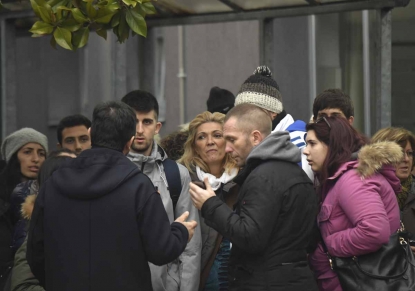 Family and friends wait for news of their loved ones outside a hospital in Pescara, January 20, 2017.
(AFP / Andreas Solaro)
Family and friends wait for news of their loved ones outside a hospital in Pescara, January 20, 2017.
(AFP / Andreas Solaro)Hope to find other survivors begins to fail and we return to Rome. We cheer the news three puppies have been rescued from inside the building, which means there are still air pockets inside. We are exaggeratedly pleased, as if this could be the turning point in the tragedy. I do a mental check of what I'll pack if we need to set straight off again to cover the "miracle" of new survivors found.
But it's a false hope. And as more bodies are pulled from the concrete tomb, the tiredness from the trip hits me, I cry for those lost and those in mourning, and I feel guilty about leaving them there and returning home, unscathed, and ready to move on to the next breaking news.
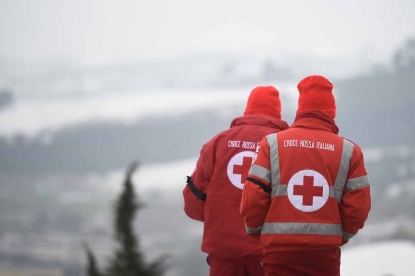 (AFP / Filippo Monteforte)
(AFP / Filippo Monteforte)



